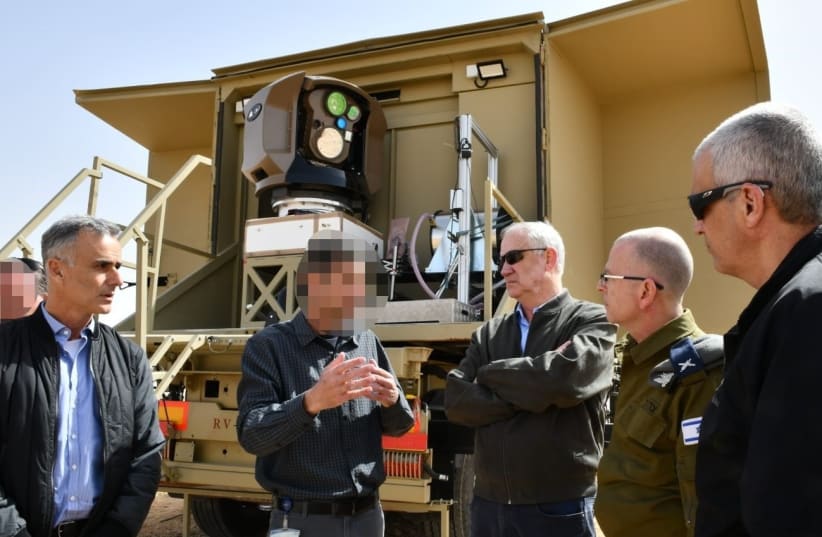Defense Minister Benny Gantz has approved significant funding to develop and produce a high-powered laser system that will intercept a range of possible aerial threats.
The Defense Ministry will sign an agreement in a few days with Rafael Advanced Defense Systems to develop the system, which will be integrated into Israel’s multi-tier air defense array. The initial investment amounts to hundreds of millions of shekels.
The Defense Ministry’s Directorate of Research and Development (DDR&D, or MAFAT in Hebrew), has been working on two laser-based systems, and “has achieved a technological breakthrough in the development of the ‘Iron Beam’ high-power laser system,” the ministry said on Thursday.
The development of “Iron Beam” will be led by the DDR&D at the Defense Ministry, together with Rafael and Elbit Systems, which is the formal supplier of the infrastructure of the laser systems.
Following the initial investment, the next stage will include the allocation of hundreds of millions of shekels to complete the process.
Defense Ministry Director-General Amir Eshel will sign the document to enable further development.
“Today we are advancing toward a dramatic change in the battlefield and enhancing Israel’s security in the face of growing threats emanating from Gaza, Lebanon and Syria, supported by Iran and terrorist organizations,” said Gantz. “The high-power laser system constitutes a strategic change in Israel’s defense of the home front in addition to the political and operational echelons’ flexibility during combat.”
The ground-based high-powered laser is in advanced stages of research and development, and will be integrated with the Iron Dome.
In parallel, MAFAT is also working on an airborne-based high-powered laser with Elbit.
The method of airborne interception, using a powerful laser, has many advantages, including a low cost per interception – the ability to effectively intercept long-range threats at high altitudes regardless of weather conditions, and the ability to defend vast areas.


The IMOD has already successfully carried out a series of interceptions using the airborne laser system installed on a civilian plane, downing several drones.
Israel considers Iran’s nuclear program its No. 1 concern, and though Iran has consistently denied seeking to build a nuclear bomb, tensions have risen as the West seeks to sign a nuclear deal with Tehran.
The Islamic Republic also continues to develop ballistic missiles capable of carrying nuclear warheads that would take less than 15 minutes to reach Israel. Iran has several rockets that could reach Israeli territory, including the Khoramshahr 2 with a range of up to 2,000 kilometers, and Shahab-3.
The IDF says that Iran’s conventional missile threat is a major worry for Israel, which despite its multi-layered air defenses, may not be able to cope with intensive missile barrages fired by Iran and its proxy groups like Hezbollah in Lebanon or Shi’ite militias in Iraq.
Israel’s comprehensive protective umbrella that counters the growing missile threats include the Iron Dome designed to shoot down short-range rockets, the Arrow (Arrow-2 and Arrow-3) system that intercepts ballistic missiles outside of the Earth’s atmosphere, and the David’s Sling missile defense system, which is designed to intercept tactical ballistic missiles, medium- to long-range rockets, as well as cruise missiles fired at ranges between 40km and 300km.
The systems are expensive, with interceptor missiles costing tens of thousands to millions of dollars each, while rockets fired from the Gaza Strip cost just a fraction of that.
The laser system, meanwhile, which costs a few dollars per pulse, is expected to be used alongside the Iron Dome to intercept aerial threats.
“We will do everything we can and allocate the necessary resources to complete the process as quickly as possible, and I am sure that along with the unprecedented operational and security gain, our investment will also lead to great economic gain for the State of Israel and ground-breaking collaborations with our allies,” Gantz said.
Terror groups in the Gaza Strip like Hamas and Palestinian Islamic Jihad have already tested the Iron Dome’s ability to deal with heavy barrages. During the last war in May, they fired over 4,000 rockets, missiles, and mortars.
Following that round of combat, known as Operation Guardian of the Walls, IDF officials urged defense manufacturers to speed up their work on the systems, and to have at least one of them operational by the middle of this year.
But according to Brig.-Gen. Yaniv Rotem, head of Military R&D in the Defense Ministry, the project will take several years before it will be operational.
Last year Rotem said that the ground system will also be able to destroy targets at a range of eight to 10 kilometers with a 100-kilowatt laser, but Rotem said on Thursday that they have gone beyond 100 kilowatts.
The system is to be first deployed in southern Israel by the Gaza Strip.
“The fruition of this program based on high-power laser technology is the product of many years of investment, led by the DDR&D’s Research and Development Division together with the defense industries,” Rotem said. “Our decision to incorporate laser systems will lead to a significant increase in Israel’s defense capabilities.”

